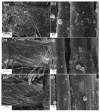Protective Multifunctional Fibrous Systems Based on Natural Fibers and Metal Oxide Nanoparticles
- PMID: 34451193
- PMCID: PMC8402111
- DOI: 10.3390/polym13162654
Protective Multifunctional Fibrous Systems Based on Natural Fibers and Metal Oxide Nanoparticles
Abstract
In recent years, an unprecedented increase in the development of products and technologies to protect the human being has been observed. Now, more than ever, the world population is exposed to several threats, harmful to their well-being and health. Chemical and biological hazardous agents stand out as one of the biggest threats, not only for the military forces, but also for the civilians. Consequently, it's essential to develop personal protective systems that are able to protect their user, not only passively, but actively, being able to detect, adsorb, degrade and decontaminate pesticides, pollutants, microorganisms and most importantly: chemical/biological warfare agents. One recent strategy for the development of active fibrous structures with improved functions and new properties is their functionalization with nanoparticles (NPs), especially metal oxides. Although their known effectiveness in the decomposition of harmful agents, the NPs could also include other functionalities in the same structure using low quantities of material, without adding extra weight, which is of huge importance for a soldier in the battlefield. The use of natural fibers as the substrate is also very interesting, since this material is a much sustainable alternative when compared to synthetic ones, also providing excellent properties.
Keywords: BWAs; CWAs; advanced protection; metal oxide nanoparticles; multifunctional fibrous structures; natural fibers.
Conflict of interest statement
The authors declare no conflict of interest.
Figures










Similar articles
-
Recent Trends in Protective Textiles against Biological Threats: A Focus on Biological Warfare Agents.Polymers (Basel). 2022 Apr 14;14(8):1599. doi: 10.3390/polym14081599. Polymers (Basel). 2022. PMID: 35458353 Free PMC article. Review.
-
The Minderoo-Monaco Commission on Plastics and Human Health.Ann Glob Health. 2023 Mar 21;89(1):23. doi: 10.5334/aogh.4056. eCollection 2023. Ann Glob Health. 2023. PMID: 36969097 Free PMC article. Review.
-
Metal oxide nanoparticles for the decontamination of toxic chemical and biological compounds.Int J Pharm. 2020 Jun 15;583:119373. doi: 10.1016/j.ijpharm.2020.119373. Epub 2020 Apr 24. Int J Pharm. 2020. PMID: 32339629
-
Searching for Natural Conductive Fibrous Structures via a Green Sustainable Approach Based on Jute Fibers and Silver Nanoparticles.Polymers (Basel). 2018 Jan 11;10(1):63. doi: 10.3390/polym10010063. Polymers (Basel). 2018. PMID: 30966097 Free PMC article.
-
Effect of plasma etching on destructive adsorption properties of polypropylene fibers containing magnesium oxide nanoparticles.Arch Environ Contam Toxicol. 2012 Feb;62(2):185-94. doi: 10.1007/s00244-011-9702-y. Epub 2011 Aug 18. Arch Environ Contam Toxicol. 2012. PMID: 21850511
Cited by
-
Extraction, characterization and properties evaluation of pineapple leaf fibers from Azores pineapple.Heliyon. 2024 Feb 20;10(4):e26698. doi: 10.1016/j.heliyon.2024.e26698. eCollection 2024 Feb 29. Heliyon. 2024. PMID: 38434067 Free PMC article.
-
The dual activity of CaONPs as a cancer treatment substance and at the same time resistance to harmful microbes.Sci Rep. 2023 Dec 22;13(1):22940. doi: 10.1038/s41598-023-49637-6. Sci Rep. 2023. PMID: 38135693 Free PMC article.
-
Recent Trends in Protective Textiles against Biological Threats: A Focus on Biological Warfare Agents.Polymers (Basel). 2022 Apr 14;14(8):1599. doi: 10.3390/polym14081599. Polymers (Basel). 2022. PMID: 35458353 Free PMC article. Review.
-
Wetspun Polymeric Fibrous Systems as Potential Scaffolds for Tendon and Ligament Repair, Healing and Regeneration.Pharmaceutics. 2022 Nov 19;14(11):2526. doi: 10.3390/pharmaceutics14112526. Pharmaceutics. 2022. PMID: 36432717 Free PMC article. Review.
-
Nanoparticle Synthesis and Their Integration into Polymer-Based Fibers for Biomedical Applications.Biomedicines. 2023 Jun 29;11(7):1862. doi: 10.3390/biomedicines11071862. Biomedicines. 2023. PMID: 37509502 Free PMC article. Review.
References
-
- Bhuiyan M.A.R., Wang L., Shaid A., Shanks R.A., Ding J. Advances and applications of chemical protective clothing system. J. Ind. Text. 2018:1–42. doi: 10.1177/1528083718779426. - DOI
-
- Binder M.K., Ackerman G.A. Pick Your POICN: Introducing the Profiles of Incidents involving CBRN and Non-State Actors (POICN) Database. Stud. Confl. Terror. 2019:1–25. doi: 10.1080/1057610X.2019.1577541. - DOI
-
- Bakowski P. CBRN Terrorism: Threats and the EU Response. [(accessed on 20 July 2020)];2015 Available online: https://www.europarl.europa.eu/thinktank/en/document.html?reference=EPRS....
-
- Vu A., Ho K., Lee C. Removal of gaseous sulfur and phosphorus compounds by carbon-coated porous magnesium oxide composites. Chem. Eng. J. 2016;283:1234–1243. doi: 10.1016/j.cej.2015.08.083. - DOI
Publication types
Grants and funding
LinkOut - more resources
Full Text Sources

